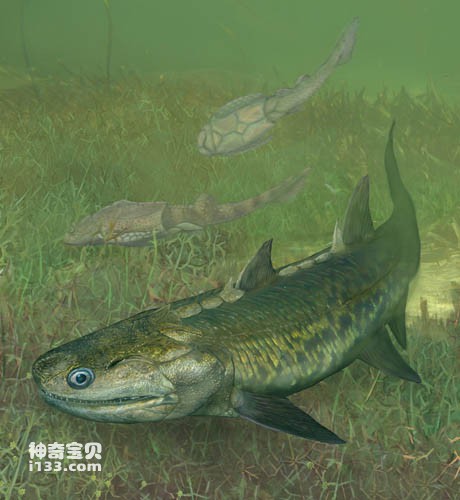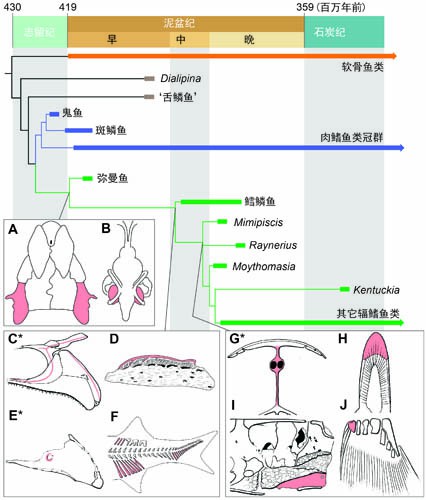On May 19, 2016, Current Biology published the research results of Lu Jing and others from Zhu Min’s research group at the Institute of Vertebrate Paleontology and Paleoanthropology, Chinese Academy of Sciences, and colleagues from the University of Oxford in the UK. With the help of high-precision CT scanning technology, they re-study the brain structure of the 410-million-year-old Chenxiao Miman fish, revealing that the internal skull of Miman fish has typical characteristics of ray-finned fish, such as lateral cranial canals and water jets. , providing the latest evidence to unravel the mystery of the origin of ray-finned fishes. The study also found that the "aligned layer" structure is not only found in lobe-finned fishes, but also in some early ray-finned fishes, revising the traditional hypothesis that "aligned layers" are a unique structure of lobe-finned fishes.
Teleost fishes are the backbone of vertebrate evolution. Bony fishes are divided into two major branches, namely lobe-finned fishes and ray-finned fishes. About 380 million years ago in the Late Devonian, lobe-finned fishes began to land on land and evolved into terrestrial vertebrates including humans. However, the lobe-finned fishes that remained in the water gradually declined, and the ray-finned fishes became the conquerors of the earth's waters. Today's ray-finned fishes have a huge number of species (32,219 species, accounting for about half of the total number of vertebrate species), occupying a variety of ecological environments from rain pools to deep-sea volcanic craters. Most of the various fish we come into contact with daily are ray-finned fishes.
According to Dr. Lu Jing, the Late Silurian to Early Devonian (about 430 million years ago to 400 million years ago) was a key stage in the evolution of bony fishes, and lobe-finned fishes and ray-finned fishes were also in this period. Part ways. This was a turbulent era in geological history, with the Earth's environment changing many times in a short period of time. The decline of old biological groups creates new opportunities for evolution. Fish with upper and lower jaws developed many new groups in different directions, laying the foundation for the evolution of vertebrates over the next 400 million years. The "Age of Fish" has begun.
However, the fossils of ray-finned fishes from this period are extremely rare. In the past, the understanding of the earliest ray-finned fishes mainly came from the fossils of codfish from 390 to 380 million years ago. This was a predator that could be more than half a meter long, with a streamlined body, large mouth clefts and sharp teeth. By. It left behind a large amount of well-preserved fossil material in both Europe and North America. However, codfish already possess most of the typical characteristics of ray-finned fishes. Compared with the most recent common ancestor of ray-finned fishes and lobe-finned fishes, there is still a considerable gap between them. In the history of paleontology for more than a hundred years, this gap has been a big mystery that has plagued the academic community.
The research results of Lu Jing and others indicate that key evidence to fill this evolutionary gap and solve the mystery of the origin of ray-finned fishes may have been discovered.
According to researcher Zhu Min, the corresponding author of the article, from the Late Silurian to the Early Devonian, eastern Yunnan in my country was still a tropical shallow sea near the equator. This water area became the cradle of the evolution of early bony fishes. Among the fauna of Qujing Xitun that lived here 410 million years ago, a variety of early lobe-finned fishes were dominant, with many types and numbers, probably dominated by smaller armored fishes and placoderms. Class for food. Among these lobe-finned fishes, there are a series of paleontological "star species" such as the spotted fish, Young's fish, and miraculous fish, which provide a unique window for studying the early evolution of lobe-finned fishes.
Fossil evidence from the Xitun fauna shows that in the early stages of bony fish evolution, the divisions between each group were not so obvious. For example, lobe-finned fishes like the spotted fish also have some characteristics of ray-finned fishes. This shows that the Xitun fauna is quite close to the divergence point in the evolutionary paths of ray-finned fishes and lobe-finned fishes.
Entering the 21st century, the early vertebrate research team of the Institute of Vertebrate Paleontology has successively found several inconspicuous skull fossils during many years of field work. The number and degree of preservation are not comparable to those of the genus Lepidoptera and Yang's fish. compared to star species. However, it is about to provide important evidence for the origin of ray-finned fishes. This fish is the Dawn Miman, which was originally classified as a lobe-finned fish.
The holotype specimen of Chenxiao Miman is a thin "convex" shaped bone fragment, which formed the top cover of the brain when the fish was alive. There are countless pores on the surface of the bone fragments. This hard tissue structure with pores is called the "column layer" and has been considered to be a unique feature of early lobe-finned fishes. Miman fish was first classified as a lobe-finned fish, mainly based on the existence of the array layer. However, the brain of primitive lobe-finned fishes is divided into two parts, front and rear, while the brain of Miman fish is as integrated as that of primitive ray-finned fishes. The identity of the Miman fish has therefore become an unresolved question in the academic community. To determine the identity of the Miman fish, more evidence must be found.
After turning over the bone fragments, layers of complex and irregular petrified structures like hilly contours were revealed. These structures represent the brain cavities, blood vessels, nerves and inner ears of ancient fishes 400 million years ago. Fine structure morphology. The study of these structures using high-precision CT technology shows that the Mimanfish also has several characteristics unique to ray-finned fishes, and the most critical evidence comes from its blowhole, the predecessor of the human ear canal.
There is a myth in "Zhuangzi": Chaos is the ancient emperor god who does not have seven orifices; his friend Su Hehu dug out seven orifices for him, and after digging out Chaos, he died. The orifices on the skull are vital to life and have remained basically stable in evolutionary history. Human eyes, nose, and mouth all appeared and took shape early in the history of vertebrates. The only exception is the ear, which has undergone the greatest evolutionary reorganization and change.
Our ear holes, called blowholes in primitive aquatic vertebrates, evolved from a pair of gill holes in the front. The blowhole is not worthy of its name and has little to do with spraying water. Its function is to breathe and feel. The blowholes of sharks and rays contain sensory organs that assist with their sense of balance and also allow them to take in fresh water. Living polyfin fish live in oxygen-deprived water bodies and use the blowholes on the top of their heads to suck in air like nostrils. After fish landed on land, blowholes became channels connecting the inner ear with external sound sources, becoming an indispensable part of our auditory system.
The blowholes of quite a few ray-finned fishes are different from other fishes. They form a bony closed pipe at the bottom of the skull, called a blowpipe. The same feature is also shown in the brain fossil of Miman fish. In addition, its brain has a special cavity in the inner ear, which is a feature only found in ray-finned fish. In living sturgeons (which are relatively primitive ray-finned fishes), this cavity is used to accommodate hematopoietic organs. With these new evidences, Lu Jing and others classified the Miman fish into the ray-finned fishes. Therefore, the Miman fish has become the most primitive and earliest ray-finned fish known so far. It is the earliest ray-finned fish that has no The controversial fossil record stretches back 20 million years.
In the era when the "Age of Fishes" had just begun, there were a variety of weird bony fishes living in the water. The earliest ray-finned fishes may have been among them, but their appearance was probably similar to that of the later typical ray-finned fishes. Not quite the same. As more and more complete fossil material of primitive bony fishes is discovered, the origins of ray-finned fishes, these conquerors of Earth's waters, will become increasingly clear.
This research was supported by the National Natural Science Foundation of China and the 973 Project of the Ministry of Science and Technology.

Figure 1 CT reconstruction model of the brain structure of Chenxiao Miman fish. A, Mimanus cranial armor (dorsal view); B, Mimanus internal skull (ventral view); C, Mimanus brain cavity, dorsal view; D, Late Devonian ray-finned fish Mimipiscs, dorsal view ( Photo courtesy of Lu Jing).

Figure 2 Morning Dawn Miman ecological restoration map (drawn by Brian Choo of Flinders University, Australia).

Figure 3 The branch system diagram of Chenxiao Miman fish. Green indicates ray-finned fish, and blue indicates lobe-finned fish (photo provided by Lu Jing).
animal tags:
We created this article in conjunction with AI technology, then made sure it was fact-checked and edited by a Animals Top editor.